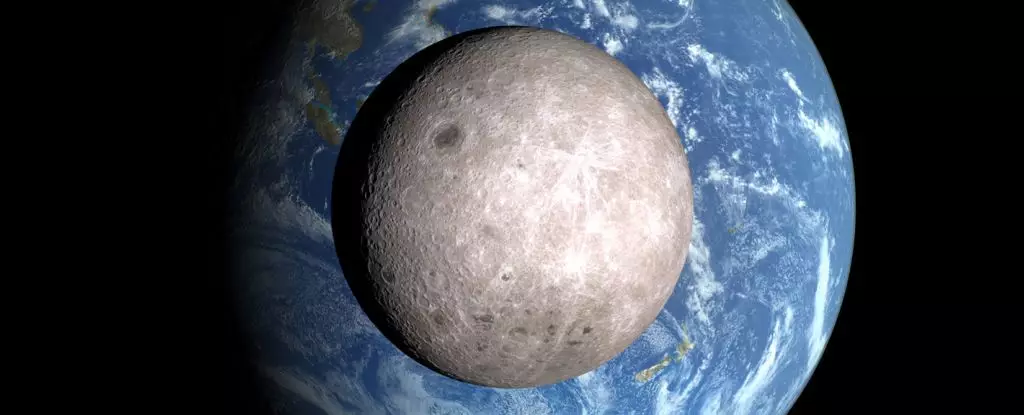The Moon, our unique celestial neighbor, has long fascinated humanity with its dichotomous terrain. Recent scientific revelations have painted a striking picture of its surface, revealing stark contrasts between the near side—the one perpetually facing Earth—and the far side, shrouded in mystery. This divide extends beyond mere appearances; it includes a puzzling imbalance in water distribution. Research stemming from China’s groundbreaking Chang’e-6 mission has unveiled that the far side possesses significantly less water compared to the Earth-facing hemisphere, underlining a curious and, some might argue, a disheartening reality about the Moon’s resource availability.
While the near side boasts serene basaltic plains—often called “maria”—the far side presents a rugged visage, marred by deep craters and a lack of large basaltic expanses. This variance is not just a surface-level observation but may hold keys to understanding the Moon’s origins and its geological development. The far side’s barren, crater-dominated landscape stands in stark contradiction to the smooth basalts formed by ancient volcanic activity on the near side, generating questions that scour the very fabric of lunar history.
Water’s Role in Lunar Origins
Understanding the implications of water distribution on the Moon is crucial for piecing together its formation narrative. The accepted theory revolves around a colossal collision between the early Earth and a Mars-sized body known as Theia over four billion years ago. This cataclysmic event yielded debris that coalesced to form the Moon, and in doing so, created an environment rich in volatile materials that would eventually shape the Moon’s geology.
In their analysis, planetary physicists Huicun He and Linxi Li emphasize the importance of understanding water content within the lunar mantle, especially on the far side. They argue that variations in hydration levels could challenge or support existing models regarding the Moon’s giant impact origins. The stark contrast in water availability evidently plays an essential role in the Moon’s evolutionary narrative, serving almost as a silent witness to the titanic events that once molded it.
Evidence and Implications of the Findings
Citing specific findings from the Chang’e-6 mission, the analysis pointed to a dramatically lower water concentration—around 1 to 1.5 micrograms per gram—within the South Pole-Aitken Basin samples. This revelation is particularly alarming and perplexing, leaving scientists grappling with the implications regarding the water scarcity on the Moon, especially given its potential significance for future explorations and endeavors aimed at harnessing lunar resources.
However, it raises a crucial question: Will this newfound understanding of lunar water distribution stifle our ambitions to exploit the Moon’s resources for future colonization or mining? Or could it simply spur innovative solutions to tackle the challenging landscape presented? The immediate conclusion would be to advocate for further exploration, further sample collection, and deeper analyses, seeking to uncover whether other regions of the far side exhibit different characteristics.
The Giant Impact Theory Revisited
Intriguingly, the disparity in hydration levels aligns with hypotheses surrounding the Moon’s giant impact genesis. The notion that this celestial event produced asymmetries in the Moon’s internal composition lends credence to the findings of the Chang’e-6 mission. Scientists suggest that the violent aftermath of the impact could have shifted geological materials, resulting in a dry, desolate surface on the far side. The more one delves into these discoveries, the more one sees the Moon not just as a silent partner in Earth’s orbit but as a complex geological entity, shaped by cataclysms and defined by spatial disparities.
In this light, the findings should not only be seen as obstacles but potentially as the beginnings of new avenues for research. If the far side proves further intricate with hidden water reservoirs or rich geochemical resources, humanity’s aspirations to expand into the galaxy could shift. Yet, the scarcity of water, unmistakably perceived, also aligns with an uncomfortable truth: our efforts to colonize other celestial bodies will inevitably face challenges rooted in resource availability.
The Future of Lunar Exploration
As scientists and policymakers contemplate the next steps in lunar exploration, we find ourselves at a pivotal moment in history. The shifting paradigm regarding lunar resource distribution beckons not just practical considerations—like how much water is available—but also broader ethical debates surrounding space exploration. Should we prioritize our endeavors based on lunar wealth, or should we engage in a more multifaceted understanding of the Moon’s history and its significance to Earth?
In an era where climate change and resource depletion raise persistent concerns, the Moon’s revelations about water and geological history prompt deep reflection on humanity’s relationship with extraterrestrial bodies. The Moon is not merely space’s backdrop; it is a reminder that our thirst for expansion should be guided by curiosity rather than conquest, reminding us to respect and understand what lies beyond our planet.


Leave a Reply